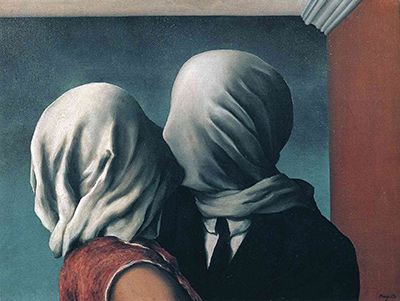In Les Amants, two people embrace in a kiss through the white fabric shielding them from one another, hiding them from sight both from each other and from the viewer.
When renowned Belgian surrealist Rene Magritte was a child, he watched his mother suffer from what may have been today described as depression. She repeatedly tried to commit suicide and eventually succeeded.
The original story was that Magritte was the one to find her when she turned up; this has since been shown to be false, and possibly was the result of a story told by Magritte's nurse. Rene Magritte's mother's body was found in a river and it is said that her face was wrapped up in the fabric of her skirt.
If this story holds any truth and Magritte saw his mother or heard the tale, then it could explain the strange fixation Magritte had on fabric-covered people such as in Les Amants and others of a similar theme.
It has also been suggested by some that his fascination with this style came from the interest many of his contemporaries had in the novel and film character Fantômas, who wore fabric draped over his face to disguise his identity.
It is impossible to say for certain what Magritte's inspiration was in displaying the lovers this way. He rarely (if ever) explained his motivations behind a theme, and certainly did not on this subject.
The mystery of the meaning leaves it open to interpretation by anyone who views the painting, and it also adds to the surrealist quality of the painting. It would not be nearly as mysterious with a clear, concise, and unambiguous statement on the underlying themes of it. Surrealism thrives on the idea of destroying the common understanding of 'normal', and to over-explain a piece would be to destroy that possibility.
Magritte painted with oil on canvas. He was talented in creating firm shapes that stood out strongly in the mind of the viewer, which added to the sense of confusion when he made the clear images so out of place from their surroundings which were often simple backgrounds of rooms, plain buildings, or uncomplicated natural scenes.
He used colours in a way very popular at his time that puts him very much in the feel of the scene of the time, although their infamy adds to their timelessness. The slightly muted tones seem bright nonetheless when displayed together, especially in the contrast of the heavy shadows in Les Amants.
Magritte shows considerable skill in making the lovers very clear despite the fabric over their face. it would be easy to turn the shape too formless, but instead it only creates an eerie barrier between the viewer and the lovers themselves.
It is poignant that the understanding of these paintings is difficult to discern. Magritte intended to bemuse the viewer by taking ordinary scenes or objects and putting them in unusual places or displaying them in an unusual manner.
Some of his most famous works are famous purely because they create a sense of unease and interest simultaneously. Les Amants is not as instantly disconcerting in the way that Le Fils de l'Homme (the suited man with an apple over his face) or even Golconde (showing men raining from the sky). Its unusual image is more subtle, showing that the simple act of taking away the view of a person's face in an image can create a sense of unease.
This is helped along by the start contrast of the pale fabric and the darker background, possibly supposed to be the sky or another wall. The dark, muted colours create an ominous feeling in the viewer, and the consequent bafflement at the unusual pose and placement of clothe adds to this discomfort. It is this effect that Magritte intended to create with his work as a whole with his talent as a surrealist.
Around the time that Magritte painted this version of 'Les Amants', he painted another with the same title and what appears to be the same scene, moved slightly. It displays the man and the woman in similar clothing standing side by side instead of embracing, though they are outside instead of beside a wall. Artists often revisit a familiar theme like this, but it is notable that they were both painted around the same time (1928), and both are named the same thing. They are also around the same size.
As Magritte was not fond of explaining himself, we cannot know whether these two paintings were supposed to be part of a set, or whether he was only temporarily interested in certain motifs. Either way the paintings have been separated by time; the one displayed here is currently in a private collection in New York, while the one with the man and the woman standing together outside is in the National Gallery of Australia. Though continents separate them, the theme remains strong.




